A Spatio-Temporal Analysis of Active Fires over China during 2003–2016
Abstract
:1. Introduction
2. Study Area, Data and Methods
2.1. Study Area
2.2. Data
2.2.1. MODIS Fire Products
2.2.2. The Data of Land Cover
2.3. Methods
2.3.1. Extract Burning Spot
2.3.2. Theil-Sen slope (TS)
2.3.3. Mann-Kendall (MK) Test
3. Results
3.1. Annual Fire Changes
3.2. Annual Fire Changes in Different Seasons
3.3. Seasonal Fire Changes
3.4. Spatial Patterns
4. Discussion
4.1. Spatio-Temporal Changes
4.2. Limitations and Prospects
5. Conclusions
Author Contributions
Funding
Acknowledgments
Conflicts of Interest
References
- Van Der Werf, G.R.; Randerson, J.T.; Giglio, L.; Collatz, G.J.; Mu, M.; Kasibhatla, P.S.; Morton, D.C.; Defries, R.S.; Jin, Y.; Van Leeuwen, T.T. Global fire emissions and the contribution of deforestation, savanna, forest, agricultural, and peat fires (1997–2009). Atmos. Chem. Phys. 2010, 10, 11707–11735. [Google Scholar] [CrossRef] [Green Version]
- Alkhatib, A.A. A review on forest fire detection techniques. Int. J. Distrib. Sens. Netw. 2014, 10, 597368. [Google Scholar] [CrossRef] [Green Version]
- Chen, Z.; Chen, D.; Zhuang, Y.; Cai, J.; Zhao, N.; He, B.; Gao, B.; Xu, B. Examining the influence of crop residue burning on local PM2.5 concentrations in Heilongjiang province using ground observation and remote sensing data. Remote Sens. 2017, 9, 971. [Google Scholar] [CrossRef] [Green Version]
- Mouillot, F.; Narasimha, A.; Balkanski, Y.; Lamarque, J.F.; Field, C.B. Global carbon emissions from biomass burning in the 20th century. Geophys. Res. Lett. 2006, 33, 1801–1805. [Google Scholar] [CrossRef] [Green Version]
- Song, Y.; Liu, B.; Miao, W.; Chang, D.; Zhang, Y. Spatiotemporal variation in nonagricultural open fire emissions in China from 2000 to 2007. Glob. Biogeochem. Cycles 2009, 23, 1–13. [Google Scholar] [CrossRef]
- Reisen, F.; Meyer, C.P.M.; Keywood, M.D. Impact of biomass burning sources on seasonal aerosol air quality. Atmos. Environ. 2013, 67, 437–447. [Google Scholar] [CrossRef]
- Field, R.D.; Van Der Werf, G.R.; Fanin, T.; Fetzer, E.J.; Fuller, R.; Jethva, H.; Levy, R.; Livesey, N.J.; Luo, M.; Torres, O.; et al. Indonesian fire activity and smoke pollution in 2015 show persistent nonlinear sensitivity to El Niño-induced drought. Proc. Natl. Acad. Sci. USA 2016, 113, 9204–9209. [Google Scholar] [CrossRef] [Green Version]
- Earl, N.; Simmonds, I. Spatial and temporal variability and trends in 2001–2016 global fire activity. J. Geophys. Res. Atmos. 2018, 123, 2524–2536. [Google Scholar] [CrossRef]
- Hu, H.-Q.; Wei, S.-J.; Sun, L. Estimation of carbon emissions due to forest fire in Daxing’an Mountains from 1965 to 2010. Chin. J. Plant. Ecol. 2013, 36, 629–644. [Google Scholar] [CrossRef]
- Mehmood, K.; Chang, S.; Yu, S.; Wang, L.; Li, P.; Li, Z.; Liu, W.; Rosenfeld, D.; Seinfeld, J.H. Spatial and temporal distributions of air pollutant emissions from open crop straw and biomass burnings in China from 2002 to 2016. Environ. Chem. Lett. 2018, 16, 301–309. [Google Scholar] [CrossRef]
- Chen, J.; Li, C.; Ristovski, Z.; Milic, A.; Gu, Y.; Islam, M.S.; Wang, S.; Hao, J.; Zhang, H.; He, C.; et al. A review of biomass burning: Emissions and impacts on air quality, health and climate in China. Sci. Total Environ. 2017, 579, 1000–1034. [Google Scholar] [CrossRef] [PubMed] [Green Version]
- Li, Y.; Zhao, J.; Guo, X.; Zhang, Z.; Tan, G.; Yang, J. The influence of land use on the grassland fire occurrence in the northeastern inner Mongolia Autonomous Region, China. Sensors 2017, 17, 437. [Google Scholar] [CrossRef] [PubMed] [Green Version]
- Prins, D.M.; Menzel, W.P. Geostationary satellite detection of biomass burning in South America. Int. J. Remote Sens. 1992, 13, 2783–2799. [Google Scholar] [CrossRef]
- Nakayama, M.; Maki, M.; Elvidge, C.D.; Liew, S.C. Contextual algorithm adapted for NOAA-AVHRR fire detection in Indonesia. Int. J. Remote Sens. 1999, 20, 3415–3421. [Google Scholar] [CrossRef]
- Giglio, L.; Descloitres, J.; Justice, C.O.; Kaufman, Y.J. An enhanced contextual fire detection algorithm for MODIS. Remote Sens. Environ. 2003, 87, 273–282. [Google Scholar] [CrossRef]
- Giglio, L.; Csiszar, I.; Restás, Á.; Morisette, J.T.; Schroeder, W.; Morton, D.; Justice, C.O. Active fire detection and characterization with the advanced spaceborne thermal emission and reflection radiometer (ASTER). Remote Sens. Environ. 2008, 112, 3055–3063. [Google Scholar] [CrossRef]
- Schroeder, W.; Oliva, P.; Giglio, L.; Quayle, B.; Lorenz, E.; Morelli, F. Active fire detection using Landsat-8/OLI data. Remote Sens. Environ. 2016, 185, 210–220. [Google Scholar] [CrossRef] [Green Version]
- Ardakani, A.S.; Valadan Zoej, M.J.; Mohammadzadeh, A.; Mansourian, A. Spatial and temporal analysis of fires detected by MODIS data in northern iran from 2001 to 2008. IEEE J. Sel. Top. Appl. Earth Obs. Remote Sens. 2011, 4, 216–225. [Google Scholar] [CrossRef]
- Palumbo, I.; Grégoire, J.; Simonetti, D.; Punga, M. Spatio-temporal distribution of fire activity in protected areas of Sub-Saharan Africa derived from MODIS data. Procedia Environ. Sci. 2011, 7, 26–31. [Google Scholar] [CrossRef]
- Molinario, G.; Davies, D.K.; Schroeder, W.; Justice, C.O. Characterizing the spatio-temporal fire regime in Ethiopia using the MODIS-active fire product: A replicable methodology for country-level fire reporting. Afr. Geogr. Rev. 2014, 33, 99–123. [Google Scholar] [CrossRef]
- Biology, G.C.; Systems, S. Global characterization of fire activity: Toward defining fire regimes from Earth observation data. Glob. Chang. Biol. 2008, 14, 1488–1502. [Google Scholar]
- Chen, D.; Pereira, J.M.C.; Masiero, A.; Pirotti, F. Mapping fire regimes in China using MODIS active fire and burned area data. Appl. Geogr. 2017, 85, 14–26. [Google Scholar] [CrossRef]
- Qin, X.L.; Li, Z.Y.; Zhang, Z.H. Spatial and temporal distribution pattern of fires in China using MODIS data. In Proceedings of the 2010 IEEE International Geoscience and Remote Sensing Symposium, Honolulu, HI, USA, 25–30 July 2010; pp. 331–334. [Google Scholar]
- Zhang, Z.; Feng, Z.; Zhang, H.; Zhao, J.; Yu, S.; Du, W. Spatial distribution of grassland fires at the regional scale based on the MODIS active fire products. Int. J. Wildl. Fire 2017, 26, 209–218. [Google Scholar] [CrossRef] [Green Version]
- Zhuang, Y.; Li, R.; Yang, H.; Chen, D.; Chen, Z.; Gao, B.; He, B. Understanding temporal and spatial distribution of crop residue burning in China from 2003 to 2017 using MODIS data. Remote Sens. 2018, 10, 390. [Google Scholar] [CrossRef] [Green Version]
- Yi, K.; Bao, Y.; Zhang, J. Spatial distribution and temporal variability of open fire in China. Int. J. Wildl. Fire 2017, 26, 122–135. [Google Scholar] [CrossRef] [Green Version]
- Shin, H.B. Urbanization in China. In International Encyclopedia of Social and Behavioral Sciences; Elsevier: Amsterdam, The Netherlands, 2015; pp. 973–979. [Google Scholar]
- Yuan, Q.; Wang, G.; Zhu, C.; Lou, D.; Hagan, D.F.T.; Ma, X.; Zhan, M. Coupling of soil moisture and air temperature from multiyear data during 1980–2013 over china. Atmosphere 2020, 11, 25. [Google Scholar] [CrossRef] [Green Version]
- Gao, X.; Shi, Y.; Song, R.; Giorgi, F.; Wang, Y.; Zhang, D. Reduction of future monsoon precipitation over China: Comparison between a high resolution RCM simulation and the driving GCM. Meteorol. Atmos. Phys. 2008, 100, 73–86. [Google Scholar] [CrossRef]
- Mao, F.; Tang, S.; Sun, H.; Zang, J. A study of dynamic change of dry and wet climate regions in the tibetan plateau over the last 46 years. Chin. J. Atmos. Sci. 2008, 32, 499–507. [Google Scholar]
- Cheng, G.; Jin, H. Pergélisol et eau de nappe sur le Plateau Qinghai-Tibet et dans le Nord-Est de la Chine. Hydrogeol. J. 2013, 21, 5–23. [Google Scholar] [CrossRef]
- Wang, Z.; Ding, Y. Climatic characteristics of rainy seasons in China. Chin. J. Atmos. Sci. 2008, 32, 1–13. [Google Scholar]
- Ke, H.; Gong, S.; He, J.; Zhou, C.; Zhang, L.; Zhou, Y. Spatial and temporal distribution of open bio-mass burning in China from 2013 to 2017. Atmos. Environ. 2019, 210, 156–165. [Google Scholar] [CrossRef]
- Justice, C.O.; Townshend JR, G.; Vermote, E.F.; Masuoka, E.; Wolfe, R.E.; Saleous, N.; Roy, D.P.; Morisette, J.T. An overview of MODIS Land data processing and product status. Remote Sens. Environ. 2002, 83, 3–15. [Google Scholar] [CrossRef]
- Pausas, J.G.; Ribeiro, E. The global fire-productivity relationship. Glob. Ecol. Biogeogr. 2013, 22, 728–736. [Google Scholar] [CrossRef]
- Giglio, L.; Schroeder, W.; Justice, C.O. The collection 6 MODIS active fire detection algorithm and fire products. Remote Sens. Envrion. 2016, 178, 31–41. [Google Scholar] [CrossRef] [PubMed] [Green Version]
- Earth Engine Data Catalog. Available online: https://developers.google.com/earth-engine/datasets/ (accessed on 30 March 2020).
- Mutanga, O.; Kumar, L. Google earth engine applications. Remote Sens. 2019, 11, 591. [Google Scholar] [CrossRef] [Green Version]
- Kumar, L.; Mutanga, O. Google Earth Engine applications since inception: Usage, trends, and potential. Remote Sens. 2018, 10, 1509. [Google Scholar] [CrossRef] [Green Version]
- Sulla-Menashe, D.; Friedl, M.A. User Guide to Collection 6 MODIS Land Cover (MCD12Q1 and MCD12C1) Product; USGS: Reston, VA, USA, 2018. [Google Scholar]
- Sulla-Menashe, D.; Gray, J.M.; Abercrombie, S.P.; Friedl, M.A. Hierarchical mapping of annual global land cover 2001 to present: The MODIS Collection 6 Land Cover product. Remote Sens. Environ. 2019, 222, 183–194. [Google Scholar] [CrossRef]
- Ten Hoeve, J.E.; Remer, L.A.; Correia, A.L.; Jacobson, M.Z. Recent shift from forest to savanna burning in the Amazon Basin observed by satellite. Environ. Res. Lett. 2012, 7, 024020. [Google Scholar] [CrossRef]
- Resampling and Reducing Resolution. Available online: https://developers.google.com/earth-engine/resample#pixel-weights-for-reduceresolution (accessed on 30 March 2020).
- Hyer, E.J.; Reid, J.S. Baseline uncertainties in biomass burning emission models resulting from spatial error in satellite active fire location data. Geophys. Res. Lett. 2009, 36, 3–7. [Google Scholar] [CrossRef]
- Theil, H. A Rank polynomial- and linear-invariant method of regression analysis. Indag. Math. 1950, 1, 386–392. [Google Scholar]
- Sen, P.K. Estimates of the regression coefficient based on kendall’s tau. J. Am. Stat. Assoc. 1968, 63, 1379–1389. [Google Scholar] [CrossRef]
- Lu, J.; Wang, G.; Gong, T.; Hagan, D.F.T.; Wang, Y.; Jiang, T.; Su, B. Changes of actual evapotranspiration and its components in the Yangtze River valley during 1980–2014 from satellite assimilation product. Appl. Clim. 2019, 138, 1493–1510. [Google Scholar] [CrossRef]
- Silva, J.M.N.; Moreno, M.V.; Le Page, Y.; Oom, D.; Bistinas, I.; Pereira, J.M.C. Spatiotemporal trends of area burnt in the Iberian Peninsula, 1975–2013. Reg. Envrion. Chang. 2019, 19, 515–527. [Google Scholar] [CrossRef]
- Xu, Z.X.; Takeuchi, K.; Ishidaira, H. Monotonic trend and step changes in Japanese precipitation. J. Hydrol. 2003, 279, 144–150. [Google Scholar] [CrossRef]
- Giglio, L. Characterization of the tropical diurnal fire cycle using VIRS and MODIS observations. Remote Sens. Envrion. 2007, 108, 407–421. [Google Scholar] [CrossRef]
- Duane, A.; Brotons, L. Synoptic weather conditions and changing fire regimes in a Mediterranean environment. Agric. Meteorol. 2018, 253–254, 190–202. [Google Scholar] [CrossRef]
- Kirchmeier-Young, M.C.; Zwiers, F.W.; Gillett, N.P.; Cannon, A.J. Attributing extreme fire risk in Western Canada to human emissions. Clim. Chang. 2017, 144, 365–379. [Google Scholar] [CrossRef] [Green Version]
- Jolly, W.M.; Cochrane, M.A.; Freeborn, P.H.; Holden, Z.A.; Brown, T.J.; Williamson, G.J.; Bowman, D.M.J.S. Climate-induced variations in global wildfire danger from 1979 to 2013. Nat. Commun. 2015, 6, 1–11. [Google Scholar] [CrossRef]
- Flannigan, M.; Cantin, A.S.; De Groot, W.J.; Wotton, M.; Newbery, A.; Gowman, L.M. Forest Ecology and Management Global wildland fire season severity in the 21st century. For. Ecol. Manag. 2013, 294, 54–61. [Google Scholar] [CrossRef]
- Di Virgilio, G.; Evans, J.P.; Blake, S.A.P.; Armstrong, M.; Dowdy, A.J.; Sharples, J.; McRae, R. Climate change increases the potential for extreme wildfires. Geophys. Res. Lett. 2019, 46, 8517–8526. [Google Scholar] [CrossRef]
- Andela, N.; Morton, D.C.; Giglio, L.; Chen, Y.; Van Der Werf, G.R.; Kasibhatla, P.S.; DeFries, R.S.; Collatz, G.J.; Hantson, S.; Kloster, S.; et al. A human-driven decline in global burned area. Science 2017, 356, 1356–1362. [Google Scholar] [CrossRef] [PubMed] [Green Version]
- Li, L.; Clarke, K.C. Cartograms showing China’s population and wealth distribution. J. Maps 2012, 8, 320–323. [Google Scholar] [CrossRef] [Green Version]
- Liu, M.; Tian, H. China’s land cover and land use change from 1700 to 2005: Estimations from high-resolution satellite data and historical archives. Glob. Biogeochem. Cycles 2010, 24, 3003–3021. [Google Scholar] [CrossRef]
- Peng, J.; Xie, P.; Liu, Y.; Ma, J. Urban thermal environment dynamics and associated landscape pattern factors: A case study in the Beijing metropolitan region. Remote Sens. Envrion. 2016, 173, 145–155. [Google Scholar] [CrossRef]
- Zhang, L.; Meng, Q.; Sun, Z.; Sun, Y. Spatial and temporal analysis of the mitigating effects of industrial relocation on the surface urban heat island over china. ISPRS Int. J. Geo Inf. 2017, 6, 121. [Google Scholar] [CrossRef] [Green Version]
- van Lierop, P.; Lindquist, E.; Sathyapala, S.; Franceschini, G. Global forest area disturbance from fire, insect pests, diseases and severe weather events. For. Ecol. Manag. 2015, 352, 78–88. [Google Scholar] [CrossRef] [Green Version]
- Kumar, S.S.; Picotte, J.J.; Peterson, B. Prototype downscaling algorithm for MODIS satellite 1 km daytime active fire detections. Fire 2019, 2, 29. [Google Scholar] [CrossRef] [Green Version]
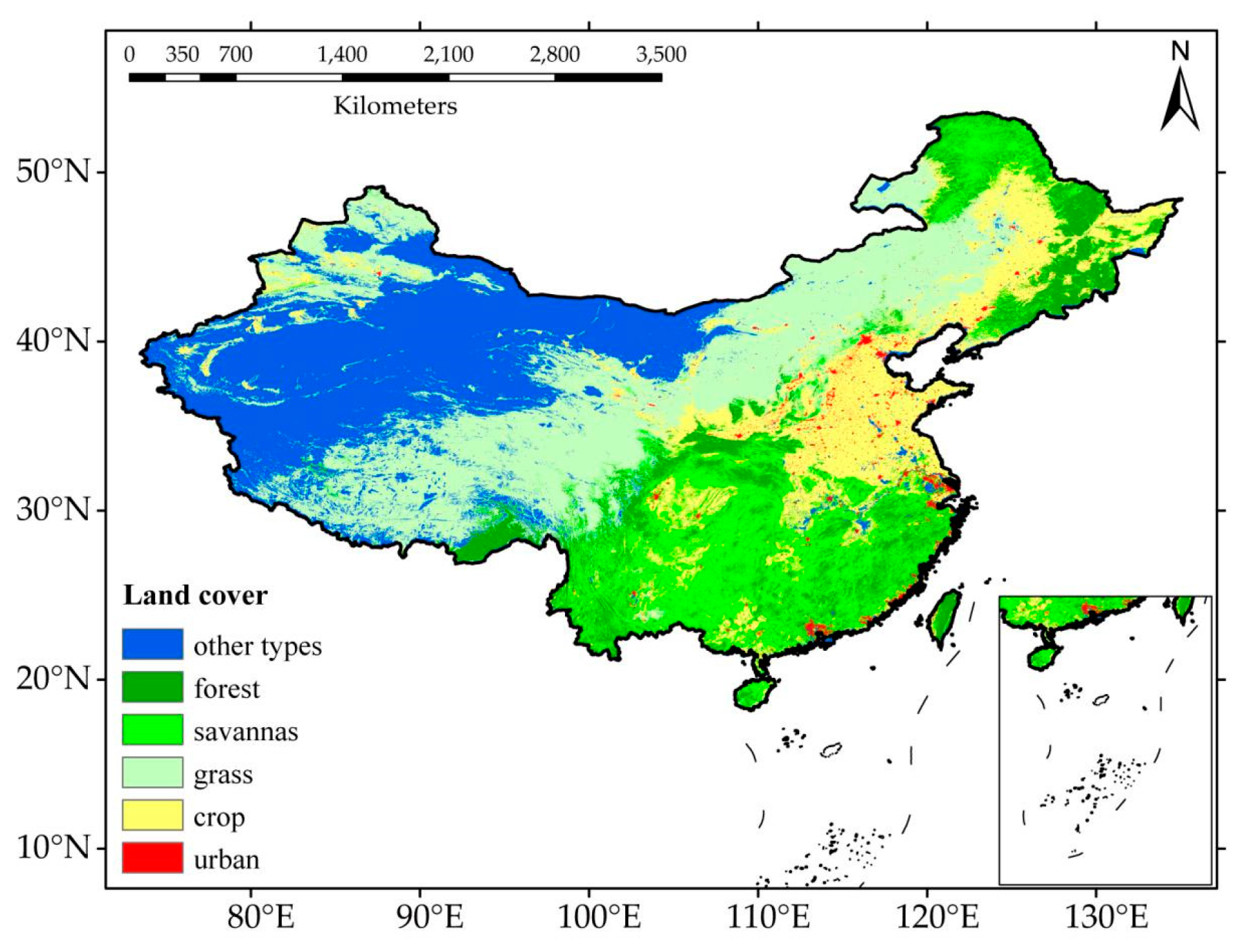
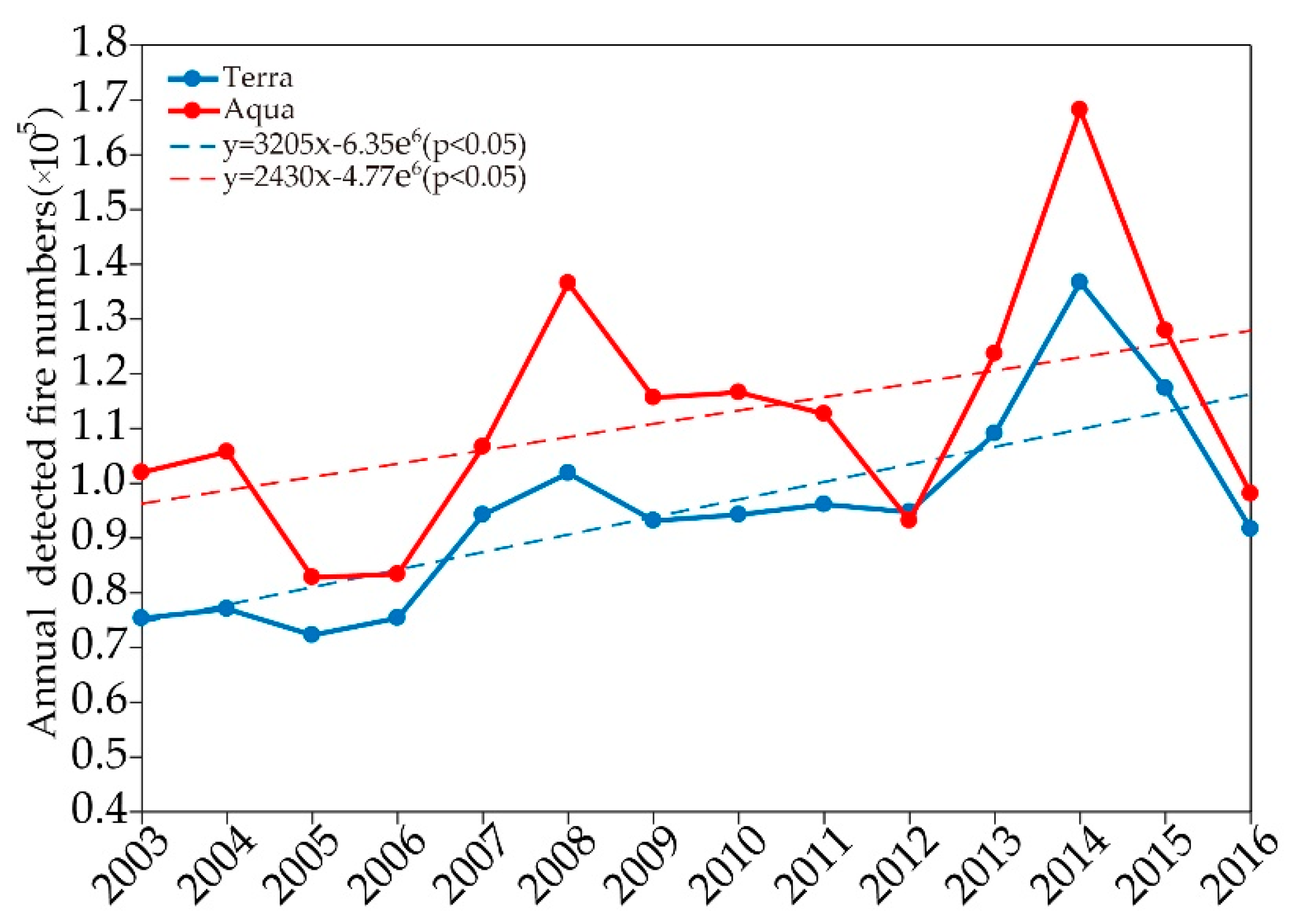

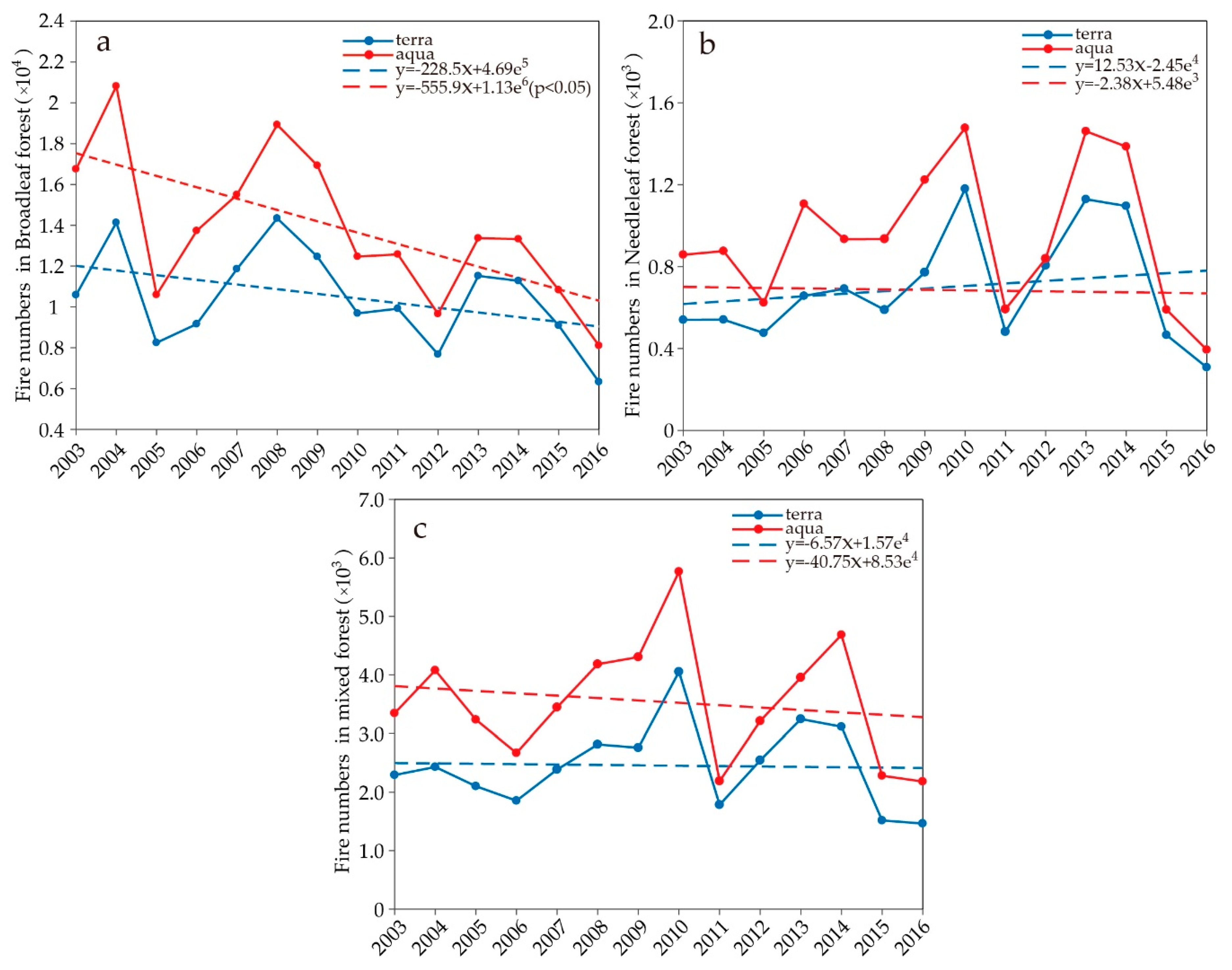
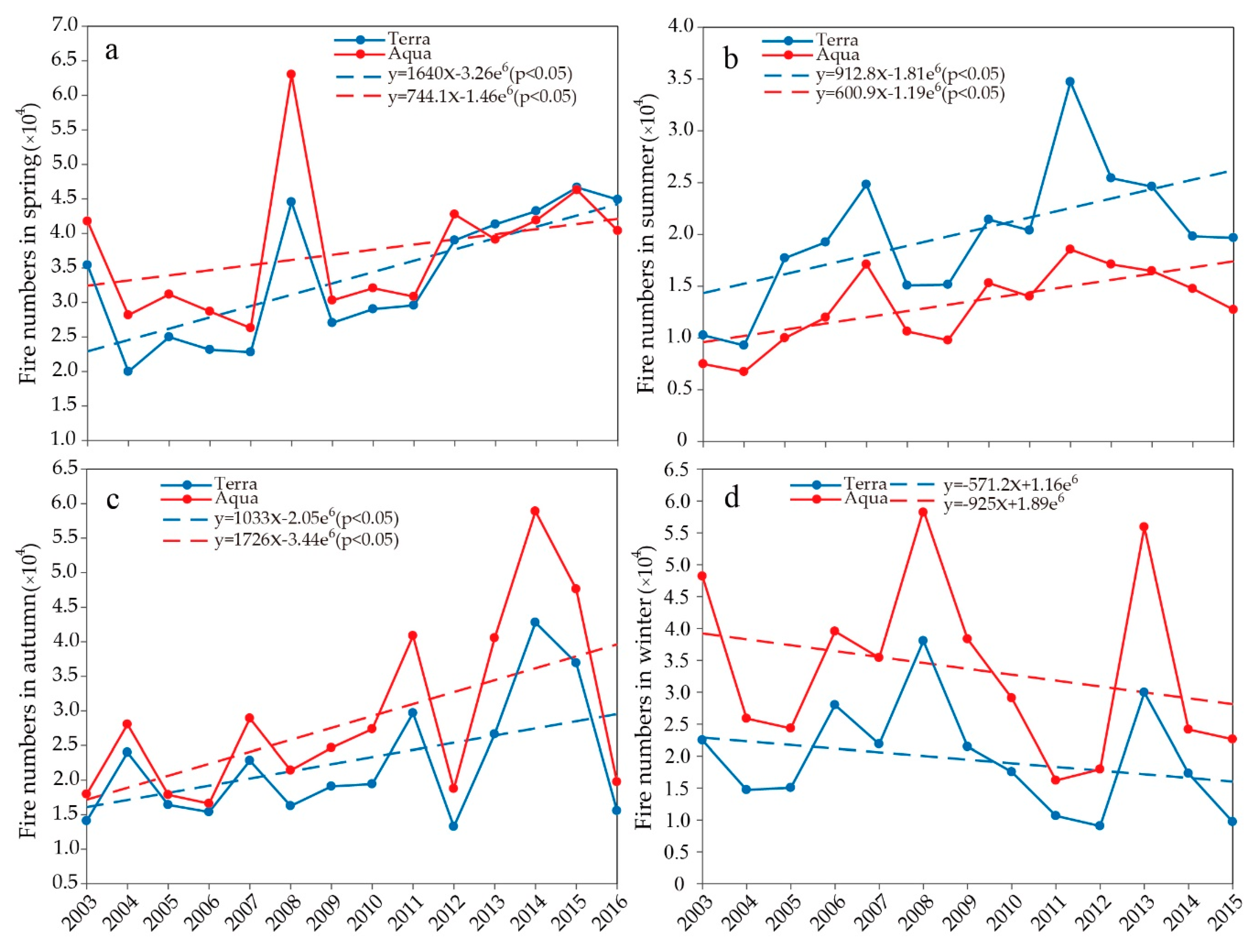
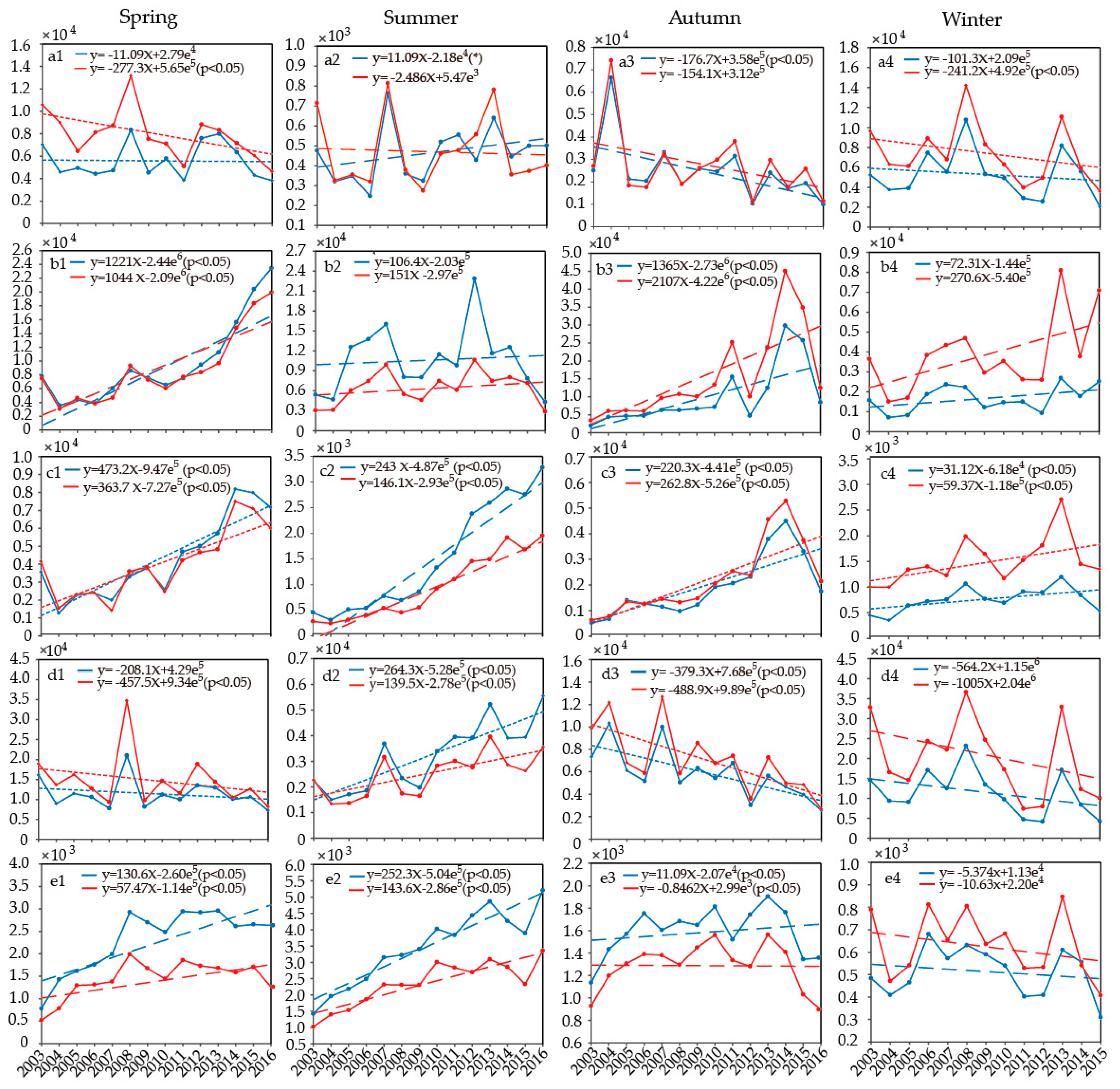

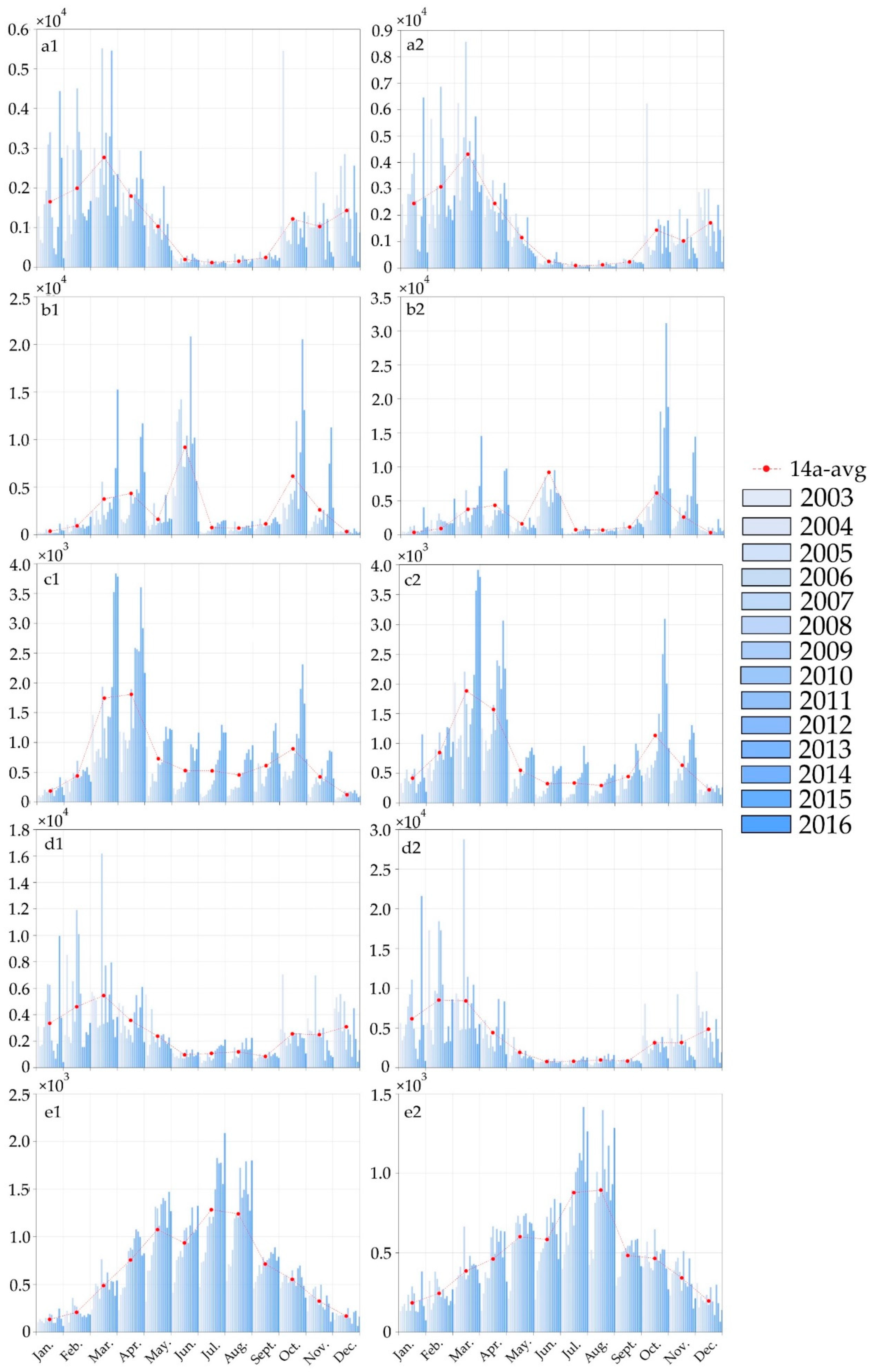
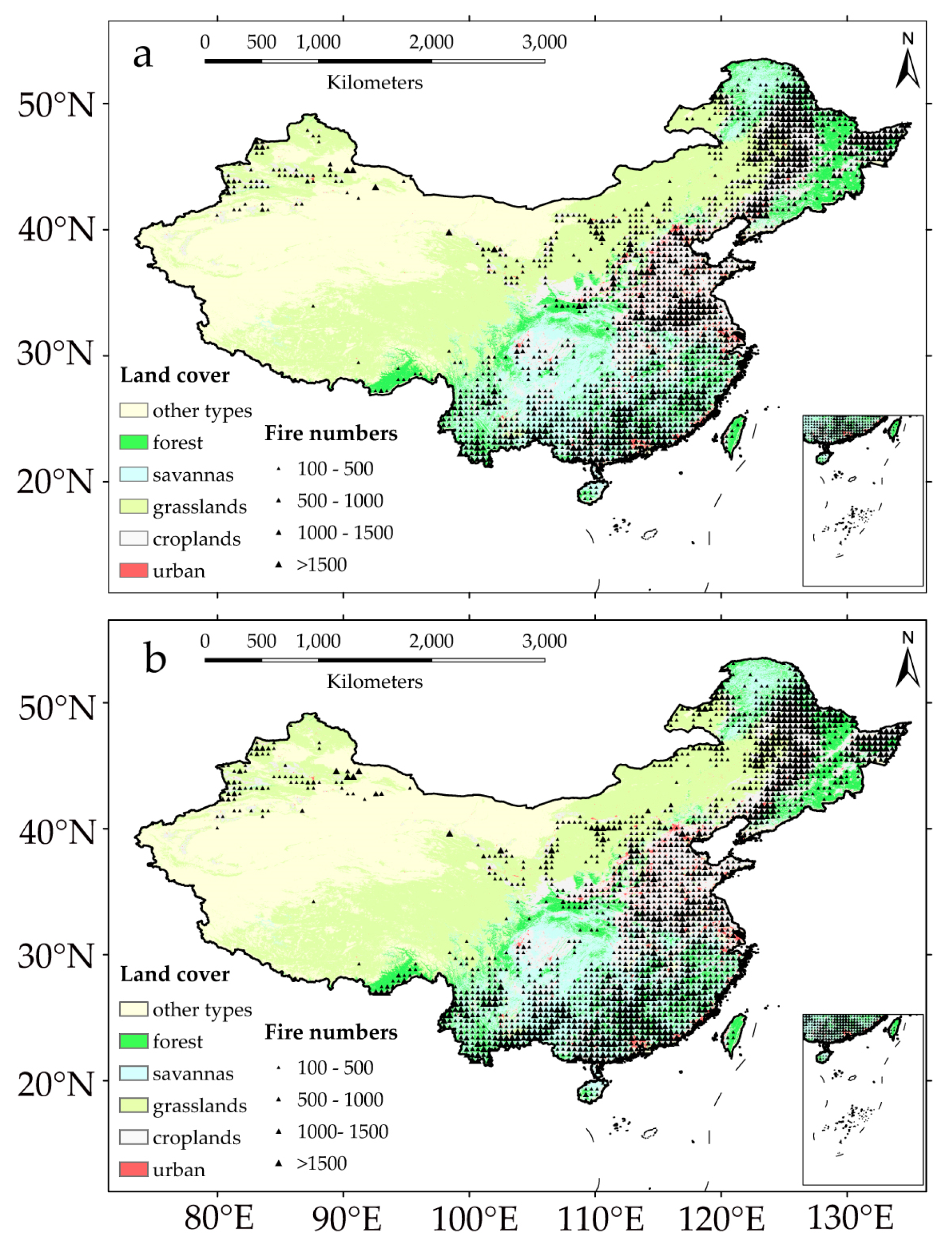


| Name | Value | Name | Value |
|---|---|---|---|
| Evergreen Needleleaf Forests | 1 | Grasslands | 10 |
| Evergreen Broadleaf Forests | 2 | Permanent Wetlands | 11 |
| Deciduous Needleleaf Forests | 3 | Croplands | 12 |
| Deciduous Broadleaf Forests | 4 | Urban and Built-up Lands | 13 |
| Mixed Forests | 5 | Croplands/Vegetation Mosaics | 14 |
| Closed Shrublands | 6 | Permanent Snow and Ice | 15 |
| Open Shrublands | 7 | Barren | 16 |
| Woody Savannas | 8 | Water Bodies | 17 |
| Savannas | 9 | Unclassified | 255 |
| Forests | Croplands | Grasslands | Savannas | Urban | Other Types | |
|---|---|---|---|---|---|---|
| Terra | 14.7% | 32.8% | 8.6% | 34.3% | 8.2% | 1.6% |
| Aqua | 16.6% | 29.9% | 7.6% | 40.1% | 5.2% | 1.2% |
© 2020 by the authors. Licensee MDPI, Basel, Switzerland. This article is an open access article distributed under the terms and conditions of the Creative Commons Attribution (CC BY) license (http://creativecommons.org/licenses/by/4.0/).
Share and Cite
Wei, X.; Wang, G.; Chen, T.; Hagan, D.F.T.; Ullah, W. A Spatio-Temporal Analysis of Active Fires over China during 2003–2016. Remote Sens. 2020, 12, 1787. https://doi.org/10.3390/rs12111787
Wei X, Wang G, Chen T, Hagan DFT, Ullah W. A Spatio-Temporal Analysis of Active Fires over China during 2003–2016. Remote Sensing. 2020; 12(11):1787. https://doi.org/10.3390/rs12111787
Chicago/Turabian StyleWei, Xikun, Guojie Wang, Tiexi Chen, Daniel Fiifi Tawia Hagan, and Waheed Ullah. 2020. "A Spatio-Temporal Analysis of Active Fires over China during 2003–2016" Remote Sensing 12, no. 11: 1787. https://doi.org/10.3390/rs12111787







